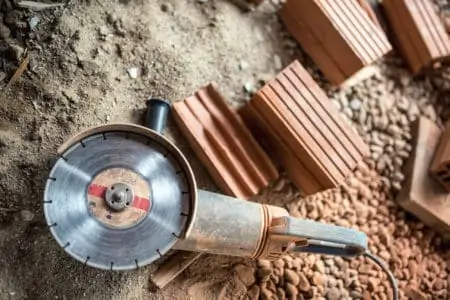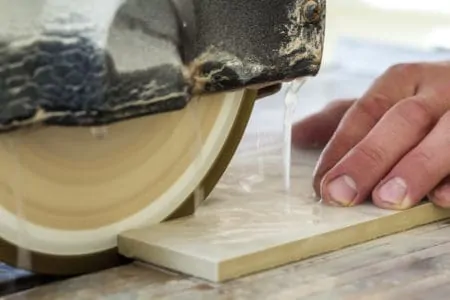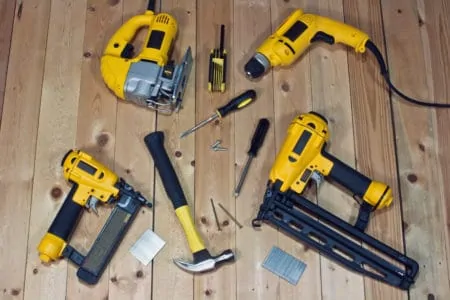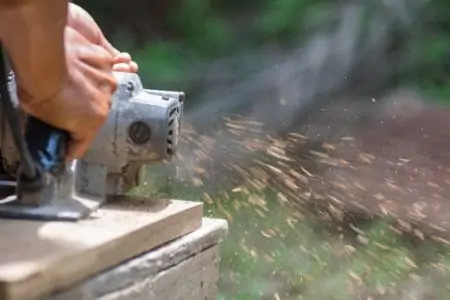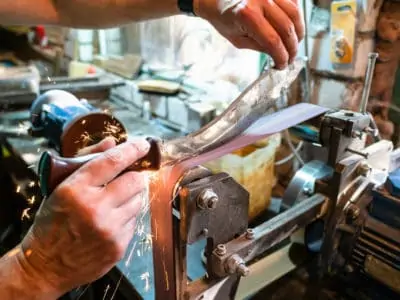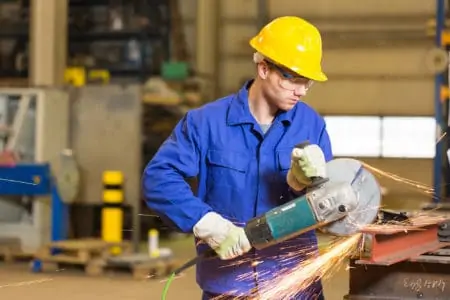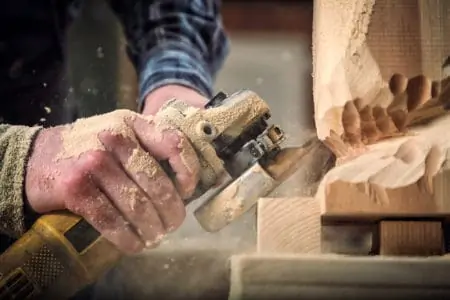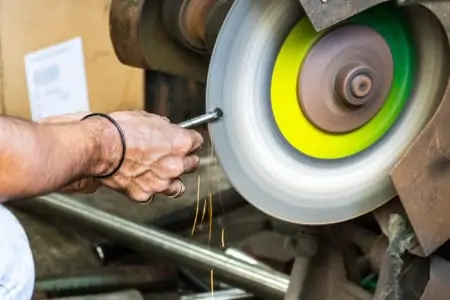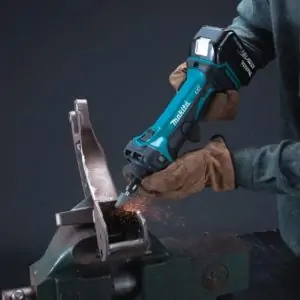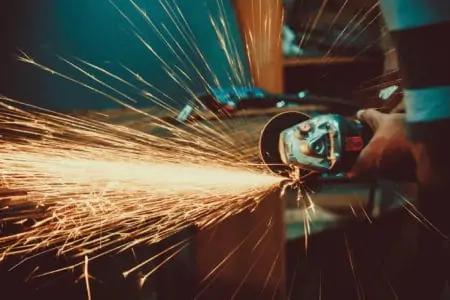If you think your angle grinder is suitable for grinding only, you might be surprised. It has a multitude of uses, with some more obvious than others.
We explore angle grinder uses to discover just how versatile this power tool is. Let’s take a look.
Key Takeaways
- Angle grinders are versatile tools used for cutting, grinding, sanding, and polishing in various industries like construction, metalworking, woodworking, and automotive.
- Construction uses include cutting tiles, sharpening tools, and drilling with a drill chuck attachment.
- In metalworking, angle grinders can help with rust removal, cleaning metal surfaces, cutting metal, and cleaning welds.
- Woodworking applications involve carving wood, planing wood, sanding wood, and paint removal from various surfaces.
Angle Grinder Uses
No matter what industry you work in, you will be familiar with angle grinders. From construction to metalworking and automotive to woodworking, we show you how versatile these power tools are.
Construction
Cut Tiles
Angle grinders are great for cutting straight clean lines, and when you need to shape and cut ceramic tiles, it is the ideal tool. It beats cutting each tile using a tile cutting tool and speeds up the job. They do much the same job as a wet tile saw, minus the water.
Smaller angle grinders are better for this task, and you should use a diamond-coated cutting wheel, as this puts the least amount of stress on the tile, which reduces instances of cracking.
Sharpening Tools
If you lack a bench grinder, an angle grinder is the best device to use when you want to sharpen your old and blunt tools. You need to have a degree of skill to perform this task correctly, or you risk doing more damage than good.
You also need to find some way of clamping the tool, so it doesn’t wriggle about while you are working. This is crucial if you need to find specific angles because you risk ruining the tool altogether.
Drilling
Did you know you can turn your angle grinder into a drill? It’s not one of the more common uses. You can buy a drill chuck attachment that connects to your grinders spindle. Once wound on, you can change the drill bits and scale up the sizes.
The most typical drill bit attachment is the diamond-tipped variety, which makes holes in ceramic tiles and bathroom and kitchenware.
Metalworking
Rust Removal
Whenever you are working with metal, rust removal is always a factor. You can remove the rust layer with a wire brush attachment and prepare the metal beneath for repainting. It also helps to preserve the metal surface, keeping it healthier.
Auto-repair shops also love angle grinders for this reason. Plus, thanks to its shape, you can get into the tightest corners and angles.
Cleaning Metal
Just like cleaning rust, with a wire brush attachment, you can easily remove any corroded layers from metal surfaces. When you are preparing metal surfaces for treatment and repainting, you need to achieve the smoothest results.
Pitted and uneven metal makes the painting more difficult, stops it from adhering properly, and looks messy when it dries.
Cutting Metal
It’s generally accepted that angle grinders are the best tools to use for cutting metal. That’s what they were designed to do.
They can tackle all forms of metal, from steel, iron, and alloys like aluminum. You can shape and smooth the edges with the proper attachment and achieve spectacular results. You do need to protect yourself against flying sparks and make sure that the surrounding area is clear of flammable objects.
Cleaning Welds
When you make new welds, your efforts will require some cleanup, unless you are the world’s most skilled welder. An angle grinder is a perfect tool for removing rough edges on welds, leaving you with a professional finish.
When you choose an angle grinder for this task, try and get one with AC/DC capabilities so that you can power it from your welding machine.
Restoring Old Tools
You can even bring old rusted tools like shovels back to life. Use a sanding disc to remove any burrs or surface blemishes, as well as long-standing rust. You could save money in the long run because you don’t need to go out and buy new tools.
Plus, nothing is quite as satisfying as restoring an old tool, bringing it back to a usable condition, and actually using it to complete your project. There’s also quite a collectors market for old tools.
Woodworking
Carving Wood
With the right wood carving disc, you can shape and carve large wooden surfaces, as well as shaping table and chair legs. However, don’t expect precision and fine detail. Angle grinders are not the best tool to use if you want to achieve intricate results.
You need to be careful with angle grinders, especially when carving wood because the material is combustible. So to avoid increased friction, work in shorter bursts and keep a bucket of cold water handy.
Planing Wood
Planing wood is possible when you use the same carving wheel. It removes large amounts of material and gets fast results. If your project is irregular in shape, an angle grinder copes admirably, thanks to its design.
Sanding Wood
Abrasive sanding discs are the perfect attachment for removing large amounts of material from wooden surfaces. Angle grinders operate at 10,000 RPM or more, so essentially, you are turbo-charging your sanding.
You can also remove old paint and varnish with a sanding disc, plus you can scale up the grit of the disc to achieve smoother finishes.
Paint Removal
If you have painted sidings that have seen better days, ravaged by the weather, an angle grinder easily removes the flaking and faded coating to reveal the smooth wood beneath. It gives you a keyed surface for applying the new layer of paint.
And you are not just confined to removing paint from wooden surfaces. An angle grinder works just as well on metal and masonry.
Masonry
Remove Mortar
When you need to restore an old wall, the crumbling mortar needs to be removed. An angle grinder has the perfect shape for getting the grinding disc into the lines of mortar between each brick layer. Use a diamond-coated grinding wheel for the best results.
It’s far quicker than using a chisel, and you are less likely to chip the brickwork in the process. For the best results, make a couple of 0.5-inch passes in the mortar, making sure to give the brickwork enough clearance.
Stone Cutting
Not all walls are made of block or brick. In older houses, especially in rural areas, many walls are made of stone. An angle grinder slices through stone, shaping and cutting the pieces to the exact size you need.
When you need to cut smaller pieces of stone, it might be better to use a smaller grinder for precision.
Automotive
Remove Paint
Auto shops use angle grinders to remove paint. With the proper attachment, you can scrape off the surface layer without damaging the metal beneath. Also, because angle grinders are lightweight and versatile, they can tackle the awkward contours of car bodywork.
You also prepare the metal so that the new layer of paint adheres correctly, which keeps your restoration looking good for longer.
Metal Polishing
Use a buffing wheel when you polish metal surfaces. It is especially effective on aluminum and steel, achieving high-gloss finishes. You can also use the same buffing attachment to bring back the luster of old paintwork.
If you are restoring an old classic car, a buffing disc gets spectacular results.
What’s the Angle?
Don’t think that your angle grinder is only good for grinding and cutting. It has many more strings to its bow. That said, you can also buy other tools that perform some of the tasks better than an angle grinder.
If you have a make-do attitude, these additional uses will appeal, but most people wouldn’t consider drilling with an angle grinder, opting instead for a drill to complete the job.
There’s also the finish to bear in mind. Angle grinders are rough tools designed for heavy-duty applications. They are not famed for their finesse and intricate detailing.
